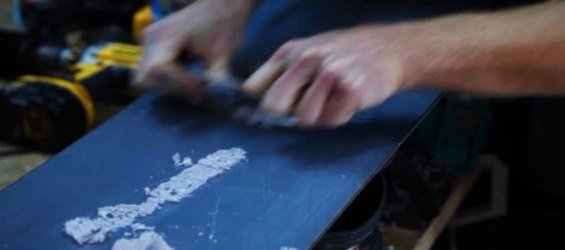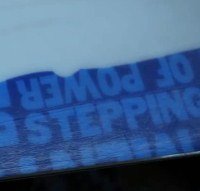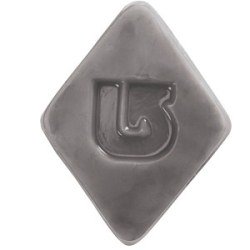
Your snowboard waxing questions answered
Recently we have been getting a lot of questions about snowboard waxing. If you haven't had much experience servicing your board then the whole subject can be a bit confusing. With this in mind we jumped into the car with the camera gear and headed down to pick the brains of the guys at our local servicing company 'Edge and Wax'. We hope what we found out will help you out the next time you are thinking of waxing your board.
Who are Edge & Wax?

Edge & Wax are a company in the south of England who earn their corn by getting ski and snowboard gear in top condition for when you go away to the mountians
if you are in the area and haven't got time to service your gear before you go away on a trip then think about giving them a visit. They certainly know their stuff.
Snowboard waxing video
Below is a short edit we put together of our time at Edge & Wax. It covers all the main areas we have been getting questions about. Learn it all about snowboard waxing in just over 3 minutes.
Want more in-depth information?
"Keep your snowboard edged and waxed for maximum control when riding"
Below are expanded answers from Adam at Edge & Wax on the questions you have been sending in about snowboard waxing. We hope they cover everything but if there is anything else you want to know then drop us an email through our contact form or post a comment on the Facebook area below.
Why is it important to get you snowboard edged and waxed?
Wax is a lubricant that allows your snowboard to run more smoothly over the snow. There are 3 types of friction you are trying to overcome: wet friction, dry friction and anti-static friction. Different waxes will help better in different conditions and it is always worth taking a note of the conditions and waxing accordingly. Having sharp edges is important so that you will hold your edge and have better control.
How often should a board be waxed, how can you tell if it needs doing?
Snowboards should be waxed when they start to get dry. Generally you will notice them getting dry along the edges and the p-tex base material will turn a whitish colour. If you run your fingernail over the base you will not be picking up wax. If it has got to this stage then they are in need of a wax. For the normal boarder you can get away with hot waxing your board after a weeks holiday.

How often should your board get edged be sharpened?
Again this depends on the snow conditions, but if you run the back of your fingernail over your edge and it is not scraping any nail off then they are in need of a sharpen. You can normally tell just by feeling your edge. After a weeks holiday it would probably be worth having your board edged.

What wax should you use on a snowboard?
There are many different waxes and you can get into a lot of detail over snowboard waxing and what suits what condition. Generally it is worth going for a universal wax, especially if you will be skiing in Europe as the conditions vary so much. However if you will be off to Canada or Scandinavia or somewhere where it is likely to be cold it is probably worth going for a harder, cold temperature snowboarding wax as this will last longer. If you are conscious of the environment and the impact that all the chemical additives that are in ski wax will have on the environment then you can go for natural waxes, or if you want a better/faster glide you can go for added fluoro content, or start layering your waxes.
Can you use candle wax or surfboard wax?
Although most ski and board waxes are hyrdrocarbon based (derived from petroleum) and so similar to candle wax, candle wax will not work on the base of your board has it does not have the glide properties that you get with specific ski and board wax.
Do different conditions require different waxes?
Dependant on how serious you wish to get with snowboard waxing then yes, different conditions require different waxes. Snowboarding wax is trying to eliminate the friction between the board and the snow and allow you to go faster and allows your board to glide more smoothly, improving your boards performance and hopefully your enjoyment. The wax you use should be slightly harder than the snow conditions.
"If conditions are very cold then you should go for a harder wax. This will help reduced dry friction"
Dependant on how serious you wish to get then yes, different conditions require different waxes. Ski wax is trying to eliminate the friction between the board and the snow and allow you to go faster and allows your board to glide more smoothly, improving your boards performance and hopefully your enjoyment. The wax you use should be slightly harder than the snow conditions. Boards actually melt the snow and run on a thin film of water. This is why the bottom of your board should not be flat, but should have a structure in it, so that it works like a cars tyre and allows the water to flow under the board and dissipate.
"A universal hot wax will be fine for 90% of riders"

If conditions are very cold then you should go for a harder wax. This will help reduced dry friction, which is the snow particles protruding through the water and running against the base, slowing the board down. However if conditions are very warm and wet it is better to use a softer wax with a higher fluorocarbon content so that you do not get wet friction from the water (reduces surface tension). Lastly something to be aware of if you are really getting into it is antistatic friction. This is caused by the snowboard passing over the snow and it has been proven that having graphite additives in your wax can shave split seconds off your time when doing races.
If this all appears too technical for you then going for a universal hot wax will be fine for 90% of users, however if you will be on dry slopes make sure you use a dry slope wax. This is very important and the heat built up on dry slopes can really damage your board and destroy your edges and so you will need a very hard wax if you will be going on dryslopes. (we really recommend using rental equipment if you are going to go to a dryslope so you do not damage your own gear.)
I have seen spray and rub on wax, is this any good compared to traditional hot wax?
These are nice to have in your pocket as a quick fix for snowboard waxing but you will find that any rub on or spray on wax will only last a few hours and does not last nearly as long as giving your board a hot wax. When you use an iron you are opening the pores of your base up and allowing wax to penetrate into the base. This means that the base absorbs a lot more wax and it slowly works its way to the surface, continually topping it up. Spray and rub on waxes only put a thin layer on the top of your base and after a day of use you will find this will have all disappeared. Have one of these in your pocket and applying at lunch is a nice idea, especially if your board is drying out towards the end of the week and you want to keep it going until you get home to give it a full wax.
Does snowboard waxing need to be done on a brand new board?
It is a good idea to wax a new snowboard. Generally when the snowboard comes out of the factory they will have run it over a waxing wheel. This does apply heat with the wax, but is not as efficient as using an iron and the wax they provide is normally a universal all purpose wax that will come off in a couple of days.
Should you take your board to a shop for snowboard waxing or can you do it yourself?
Waxing is very easy to do yourself, however it is important that you have the correct tools and you get some instruction. Do not use a home iron! Firstly whoever does the ironing of the clothes might get a bit annoyed, and it is never a good idea to steam a snowboard but also domestic irons have a temperature tolerance of roughly 15 degrees C. While specific waxing irons will only vary by 3-4 degrees C.
This is very important when snowboard waxing as most waxes will show the temperature that you need to set your iron at, but it is generally around 120 degrees C, and the epoxy that hold the p-tex base material down to the core will start to give out at around 130 degrees C causing bubbles to occur in your base material. This is very hard to fix. So you can regulate your irons temperature more easily using a specific waxing iron, and should, as long as you keep your iron moving, not have any issues.
Back to "Snowboarding home" from "Snowboard waxing"
Back to "Snowboard maintenance" from "Snowboard waxing"




New! Comment using Facebook
Want to say something about this page? Leave a comment in the box below.